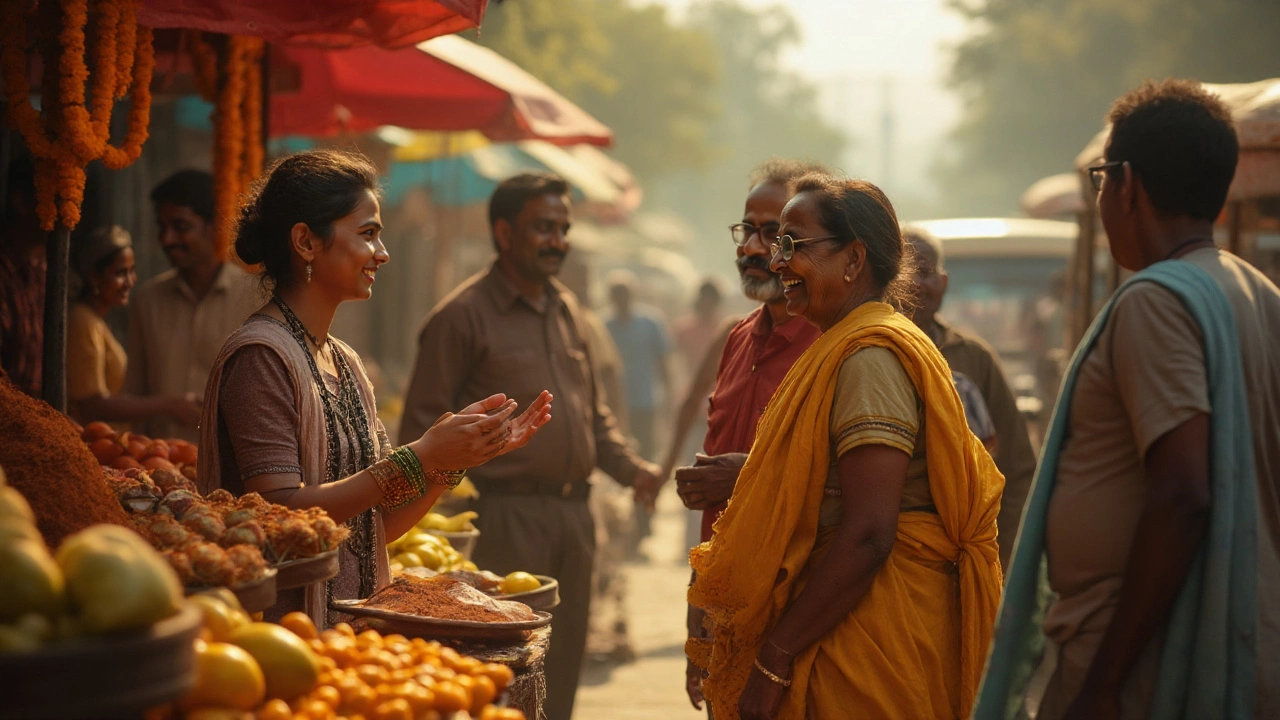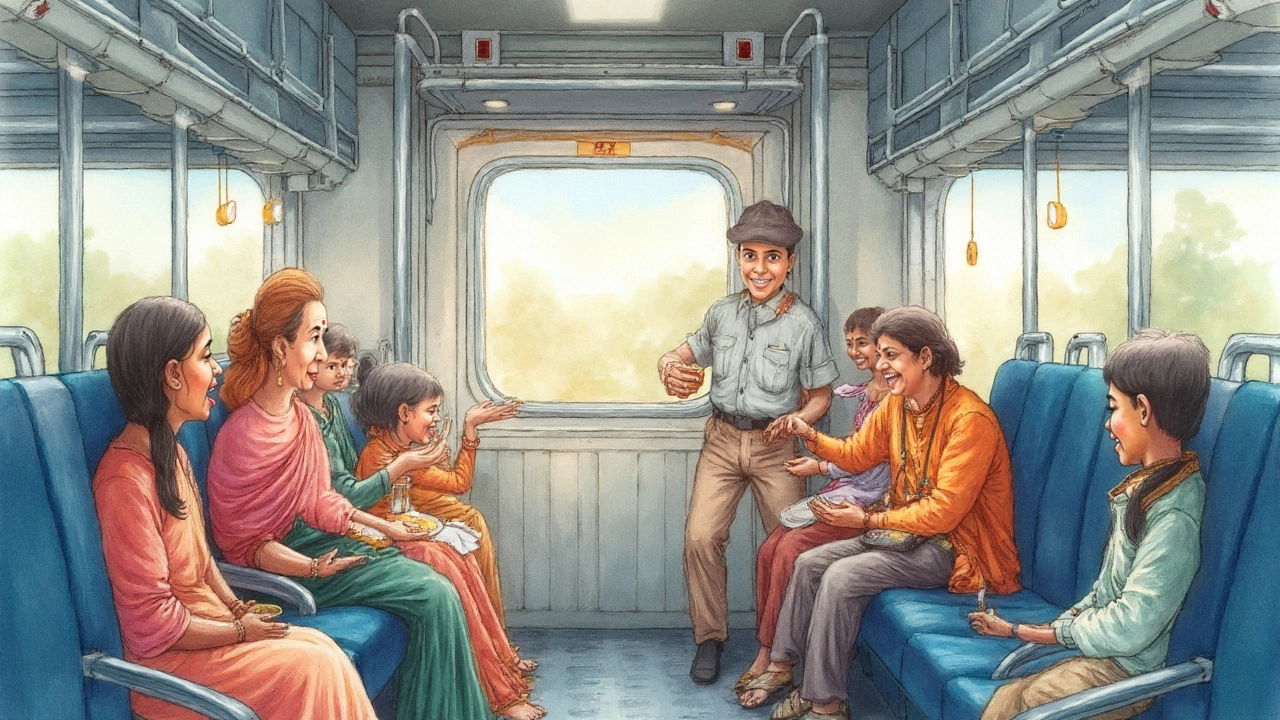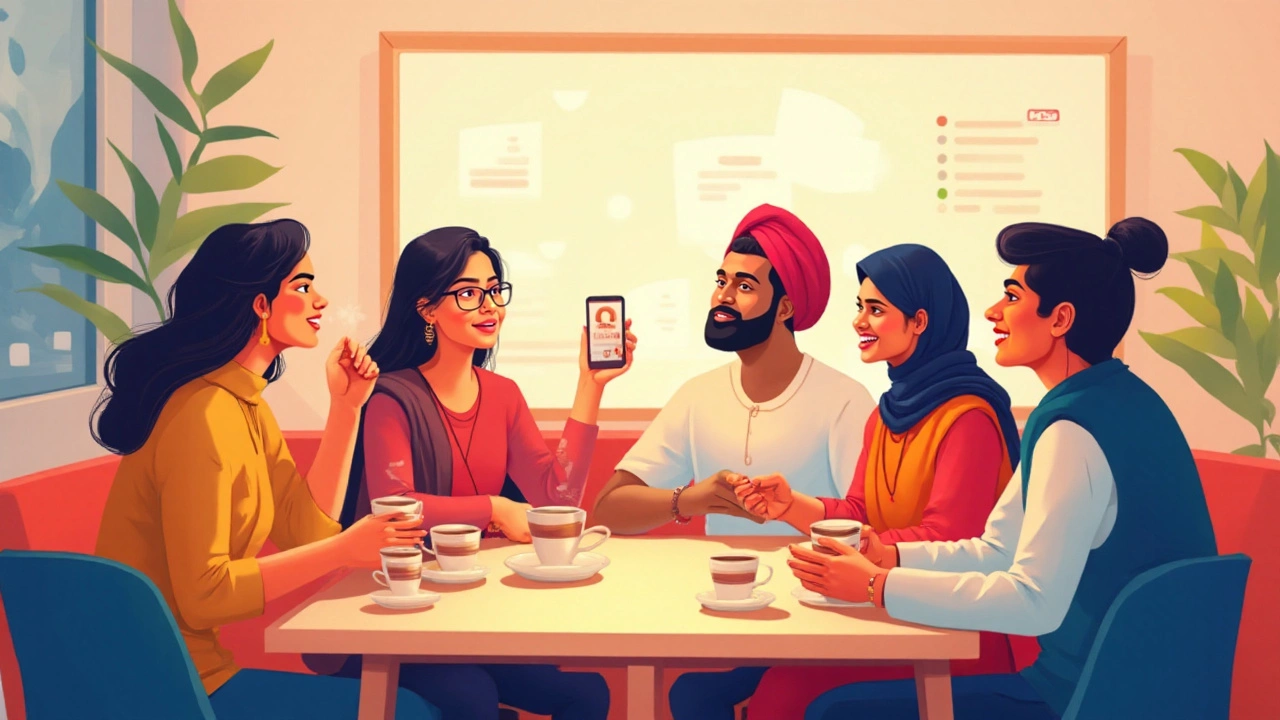
You came for the quick answer. The truth? There isn’t just one “common Indian phrase.” India runs on many languages, and people switch between them all day. But there are a few phrases you’ll hear everywhere-from a Mumbai auto ride to a Delhi office call to a Chennai café. If you want something that works across regions, start with “Namaste” (hello), “Theek hai” (okay), “Koi baat nahi” (no worries), and “Chalo” (let’s go). Then layer in thank‑yous, polite titles, and a little slang when it fits.
- TL;DR: Use “Namaste” to greet, “Shukriya” or “Dhanyavaad” for thanks, “Theek hai” for agreement, “Koi baat nahi” to say it’s okay, and “Chalo” to move things along.
- One phrase for warmth with anyone: add “ji” (respect) to names and replies-“Haan ji,” “Namaste ji.”
- When unsure, English works. Most folks mix English, Hindi, and local languages on the fly.
- Mind tone more than perfect grammar. Friendly voice beats textbook words.
- Avoid “Jugaad” at work unless you know the vibe. It can sound scrappy or reckless depending on the room.
The quick answer and your cheat sheet of everyday phrases
Let’s give you a clean, usable answer first, then the details. If you want one safe greeting that’s understood almost anywhere, go with “Namaste.” If you need a one‑word acknowledgment, say “Theek hai” (okay). To soften a situation, “Koi baat nahi” (no problem) works with strangers and friends. To move, “Chalo” (let’s go) is perfect. For gratitude, “Shukriya” (Urdu/Hindi) and “Dhanyavaad” (Sanskrit‑leaning Hindi) are both fine-“Thank you” in English is also common in cities.
That said, India isn’t one language. The Constitution recognizes 22 major languages, and according to the Census of India 2011, Hindi (and related varieties) is the most common first language, while English often serves as a link language in cities and offices. On the street, people code‑switch without thinking. So the smartest way to sound natural is to learn a handful of phrases that repeat across daily life, and swap them in when the moment calls.
- If you only remember three, memorize: “Namaste,” “Theek hai,” and “Koi baat nahi.”
- Add a warm “ji” for respect: “Namaste ji,” “Haan ji,” “Nahi ji.”
- Use “Chalo” when you want to leave, agree to start, or wrap a chat.
- For quick thanks, “Shukriya” or “Thank you” both land well.
- When in doubt, smile, nod, and keep your tone soft. That counts more than perfect wording.
Here’s a practical cheat sheet that covers greetings, gratitude, agreement, and courtesy across major languages. I’ve added simple pronunciation guides you can lean on in a pinch.
| Language / Context | Phrase | Meaning | When to Use | Politeness Tip | Pronunciation |
|---|---|---|---|---|---|
| Hindi / Urdu | Namaste / Salaam | Hello | Greeting anyone, anytime | Add “ji”: Namaste ji | nuh-MUH-stay / suh-LAAM |
| Hindi / Urdu | Theek hai | Okay / fine | Agreeing, acknowledging | Gentle tone | theek hay |
| Hindi / Urdu | Koi baat nahi | No problem / it’s okay | Soothing a slip or delay | Smile helps | koy baat nuh-HEE |
| Hindi / Urdu | Shukriya / Dhanyavaad | Thank you | Everyday gratitude | “Bahut” (very) for emphasis | SHOOK-ree-ya / DHUN-yuh-vaa-d |
| Hinglish | Chalo | Let’s go / let’s start / alright | Wrapping up, moving along | Light, upbeat | CHUH-lo |
| Hinglish | Arey yaar | Oh man / dude | Casual frustration or fondness | Friends only | uh-RAY yaar |
| Marathi (Maharashtra) | Namaskar | Formal hello | Shops, elders, formal events | Small head nod | nuh-muhs-KAAR |
| Marathi | Baray ahe / Thik aahe | It’s fine / okay | Everyday transactions | Keep it soft | BUH-ray aa-hay / theek aa-hay |
| Bengali | Nomoskar | Hello | All settings | Gentle tone | noh-mosh-KAAR |
| Bengali | Dhonnobad | Thank you | Gratitude | Warm smile | DHON-no-baad |
| Tamil | Vanakkam | Hello | Respectful greeting | Small nod, palm together optional | vah-nuh-KKUM |
| Tamil | Sari / Seri | Okay | Agreeing | Neutral tone | seh-ree |
| Telugu | Namaskaram | Hello | Polite greeting | Use with elders | nuh-muhs-KAA-rum |
| Telugu | Sare / Sāre | Okay | Agreement | Soft tone | sa-ray |
| Kannada | Namaskāra | Hello | Polite greeting | Head nod | nuh-muhs-KAA-ra |
| Kannada | Sari / Sāri | Okay | Agreement | Gentle tone | sa-ree |
| Malayalam | Namaskāram | Hello | All settings | Respectful tone | nuh-muhs-KAA-rum |
| Malayalam | Shari | Okay | Agreement | Neutral tone | sha-ree |
| Gujarati | Kem cho? | How are you? | Friendly greeting | Reply: “Majama” (I’m fine) | kame cho / muh-jaa-ma |
| Gujarati | Barabar | Okay / fine | Agreement | Light smile | bah-RAH-bar |
| Punjabi | Sat Sri Akal | Traditional Sikh greeting | Respectful hello | Use with warmth | sut sree uh-KAAL |
| Punjabi | Theek aa | It’s okay | Agreement | Casual tone | theek aa |
| Across India | Bhaiya / Didi | Brother / Sister (polite address) | Addressing service staff, strangers kindly | Add “ji” for extra respect | bhai-yaa / dee-dee |
| Across India | Maaf kijiye | Excuse me / sorry | Getting attention, apologizing | Pair with a nod | maaf KEE-jee-yay |
| Urban slang | Jugaad | Workaround / hack | Finding quick fixes | Careful in formal meetings | joo-GAAD |
In busy Mumbai trains, I hear the same cluster daily: “Chalo,” “Theek hai,” “Koi baat nahi,” “Arey yaar.” In shops, “Bhaiya” or “Didi” with a soft tone gets better help than plain “excuse me.” And when you add “ji” to a name-“Ravi ji”-you sound respectful without being stiff.
Short on time? Here’s a tiny script you can reuse: walk in with “Namaste,” make your ask in simple English, acknowledge with “Theek hai,” and end with “Shukriya.” That four‑step loop works in most day‑to‑day moments.

How to use these phrases right: tone, context, and etiquette
Indian languages are sensitive to tone. A soft “Theek hai” can sound agreeable. A flat, clipped “Theek hai” can sound annoyed. The words are the same; the music changes everything. When in doubt, keep your voice warm and a notch slower than your default.
Level up your politeness with two small tools:
- Add “ji” for respect. “Haan ji” (yes), “Nahi ji” (no), “Ravi ji” (Mr. Ravi). It’s not old‑fashioned; it’s warm.
- Use kinship terms kindly: “Bhaiya” (brother) and “Didi” (sister) go a long way with service staff, cab drivers, market vendors. If someone looks older, “Uncle/Aunty” gets mixed reactions-stick to Bhaiya/Didi if you’re unsure.
About “please”: You’ll hear it, but not after every sentence like in some countries. Indian languages often build politeness into the verb (“-jiye” ending in Hindi, as in “rukiyega”-please wait). Overusing “please” can sound stiff. Pick one “please” per request and you’re fine.
Gesture check: “Namaste” pairs nicely with a small head bow; palms together is optional outside formal or spiritual settings. Eye contact should be friendly, not intense. In crowded places (like a suburban train at rush hour), a raised hand and “Maaf kijiye” is enough to pass.
Formality filter (handy rule of thumb):
- Friends: “Arey yaar,” “Chal,” “Theek hai,” light slang.
- Work peers: “Hi,” “Theek hai,” “Thanks,” no heavy slang unless the team uses it.
- Seniors/elders: “Namaste ji,” “Bilkul” (certainly), “Maaf kijiye,” avoid slang.
When English is safer: in formal emails, presentations, or when stakes are high. People in Indian offices mix English and Hindi, but full English keeps things clear if you’re not fluent. For a respectful yes in English‑heavy rooms, “Sure” or “Sounds good” lands better than a flat “Okay.”
Gender bits worth knowing: In Hindi, verbs change with gender-“Main tayyar hoon” (I am ready) for men; many women say “Main tayyar hoon” too in casual talk, but the formal feminine is “hoon” paired with feminine past participles (e.g., “Main gayi” for I went). Don’t sweat it as a learner; nobody expects perfect grammar in small talk.
On “Jugaad”: It’s the scrappy fix India is famous (and infamous) for. Praised for creativity, criticized for cutting corners. In a startup brainstorm, it can be a compliment: “Solid jugaad.” In a compliance review, it can sound reckless. Read the room.
Regional rhythm: South Indian greetings (Vanakkam, Namaskaram, Namaskāram) feel more formal by default. In Mumbai and Delhi, Hinglish rules-English sentences with Hindi glue words like “bas,” “yaar,” “chalo,” “theek hai.” In Kolkata, you’ll hear “Acha” as acknowledgment (similar to Hindi) and “Ektu” (a little) for softening. None of this is a test. People meet you halfway if you try.
Phone and chat etiquette: On a call, open with “Hello, Namaste,” say the name, and confirm: “Aap bol rahe the?” (Were you speaking?) For text, Indians use short forms freely: “Pls,” “Tnx,” “Ok,” and even stickers for “Namaste.” Emojis help tone-🙏 with “Shukriya” reads sincere, not dramatic.
Price and bargaining moments: “Thoda kam hoga?” (Can it be a bit less?) is polite and common in street markets, not in malls. If offered water or tea during a shop chat, it’s normal. You can accept or decline with “Nahi ji, theek hai.”
Safety phrases I actually use in Mumbai: “Ek minute” (one minute) to pause a fast‑moving conversation; “Zara rukiye” (please wait a bit) when paying; “Side, please” in crowded trains; “Yahin rukna” (stop here) in cabs; and “Chutta nahin hai” (I don’t have small change) to switch to UPI or card.

Examples, mistakes to avoid, and quick FAQs
Let’s put these words into real life. Here are short, true‑to‑life snippets you can copy‑paste into your day.
common Indian phrase in a taxi: “Namaste bhaiya. Bandra jana hai. Theek hai? Shukriya.” You greeted, stated your destination, checked agreement, and thanked-all in four words plus the place name.
At a café queue: “Maaf kijiye, yahan line hai?” (Excuse me, is there a line?) If yes: “Theek hai, main wait karungi/karunga.” If someone bumps your shoulder: “Koi baat nahi.” You just lowered the temperature of the room.
With a colleague: “Chalo, 3 baje touch base? Theek hai.” That’s standard office Hinglish. If it slips, you soften: “Aaj thoda tight hai. Kal chalega?” (Today’s a bit tight. Tomorrow okay?)
With a shop vendor: “Didi, yeh kitne ka?” (Sister, how much is this?) Reply is a price. You say: “Thoda kam hoga?” If not: “Theek hai, chalo rehne do.” (Okay, leave it.) No one’s offended.
With an elder: “Namaste ji, kaise hain?” (Hello, how are you?) “Aapka aashirvaad chahiye” (I need your blessing) is culturally sweet in family settings. You don’t need it with strangers.
Common mistakes to dodge:
- Using slang with strangers. “Yaar” and “Arey” are for friends. With elders or staff, stick to Bhaiya/Didi and a soft tone.
- Over‑pleasing. Saying “please” five times in one sentence feels stiff. One “please,” or a polite verb form, is enough.
- Flat “Theek hai.” It can read as resignation or annoyance. Add a tiny lift at the end, like a smile you can hear.
- Shouting English to be understood. Volume doesn’t help; simpler words do.
- Dropping “ji” where respect matters. It’s a two‑letter fix that changes the whole vibe.
Pronunciation hacks that save you:
- The Hindi “th” in “Theek” is like the “t” in “tea,” not the English “th” in “think.”
- Retroflex “ṭ/ḍ” (tongue curls back) show up in words like “thoda” (a little). Don’t stress it; people get you.
- Vowels are short and crisp. “A” in “Namaste” is closer to “uh” than “ah.”
- Keep it musical. A gentle rise at the end of polite questions works wonders.
Mini‑FAQ
- What’s the most universal greeting? “Namaste” is widely understood. In Sikh contexts or Punjab, “Sat Sri Akal” is perfect. Down south, “Vanakkam/Namaskaram” feel native. If you blank, “Hello” is fine.
- Is “Namaste” religious? It has spiritual roots but it’s used as a secular greeting across India. In temples or rituals, it carries more weight; in daily life, it’s hello with respect.
- Namaste vs. Namaskar vs. Namaskaram-what’s the difference? Politeness dial and region. “Namaste” (north/central), “Namaskar” (Marathi, Bengali), “Namaskaram/Namaskāram” (south). Use the one you hear around you.
- What’s the safest “thank you”? “Shukriya” or “Thank you.” Both work in cities. “Dhanyavaad” sounds a bit formal or textbook, but still okay.
- Can I call a driver “bhaiya”? Yes, it’s kind and normal. “Didi” for women. Add “ji” for older people: “Bhaiya ji.”
- Is “jugaad” good or bad? Both. It praises clever fixes but can imply bending rules. In regulated settings, avoid it.
- How do I say sorry? “Sorry” works. Or “Maaf kijiye” (excuse me/forgive me). For small bumps: “Koi baat nahi.”
- How do I say please? Use tone or polite verb forms. In Hindi: “-iye” or “-iyega” endings-“Rukiye,” “Suniyega.” One “please” is enough if you stick to English.
- What’s a casual “let’s go”? “Chalo” (Hinglish). With friends: “Chal.” With elders: keep “Chaliye” to be extra polite.
- What if I mix languages by mistake? Welcome to India. Everyone mixes. No one minds as long as you’re respectful.
Next steps / Troubleshooting (by scenario)
- Traveler on day one: Memorize “Namaste,” “Theek hai,” “Koi baat nahi,” “Shukriya,” “Maaf kijiye,” and “Bhaiya/Didi.” That covers 80% of interactions.
- Expat working in a mixed office: Use English for clarity, sprinkle “Theek hai,” “Chalo,” and “Koi baat nahi” in casual chats. Add “ji” with senior colleagues when you say yes/no.
- Remote meetings with Indian teams: Start with a warm check‑in (“All well?”), acknowledge clearly (“Sounds good,” “Theek hai”), and end with “Thanks, everyone. Chalo, we’re done for today.” It reads natural without trying hard.
- Market haggling: Start at 60-70% of the first quote, smile, and use “Thoda kam hoga?” If it feels awkward, end with “Theek hai, rehne do.” No hard feelings.
- Stuck on pronunciation: Pick one anchor phrase per week. Record yourself saying “Namaste ji,” “Koi baat nahi,” “Chalo,” “Shukriya,” and compare to a native clip. Tiny practice, big payoff.
Cheat‑codes you can pocket right now:
- Agree softly: “Bilkul” (certainly) or “Theek hai, hojayega” (Okay, it’ll get done).
- Buy time: “Abhi dekh rahi/raha hoon” (I’m checking now), “Ek minute.”
- End a chat: “Chalo, milte hain” (Let’s meet), “Main chalta/chalti hoon” (I’ll get going).
- Ask gently: “Zara” (just a bit) before a verb-“Zara help kijiye.”
- Say no without sting: “Abhi mushkil hai” (Tough right now), “Shayad kal” (Maybe tomorrow).
If you’re still wondering which phrase wins the crown, it’s “Theek hai.” You’ll hear it in every city, office, bazaar, and family WhatsApp group. It’s the Swiss Army knife of Indian talk-agreement, acceptance, or a soft landing when no one wants to fight over details. Pair it with “Namaste,” “Koi baat nahi,” and “Chalo,” and you’ll sound like you’ve been here a while, even if you just got off the plane.
One last comfort: people here forgive grammar fast but remember kindness. Show respect with “ji,” keep your tone warm, and smile. The rest, the city will teach you.